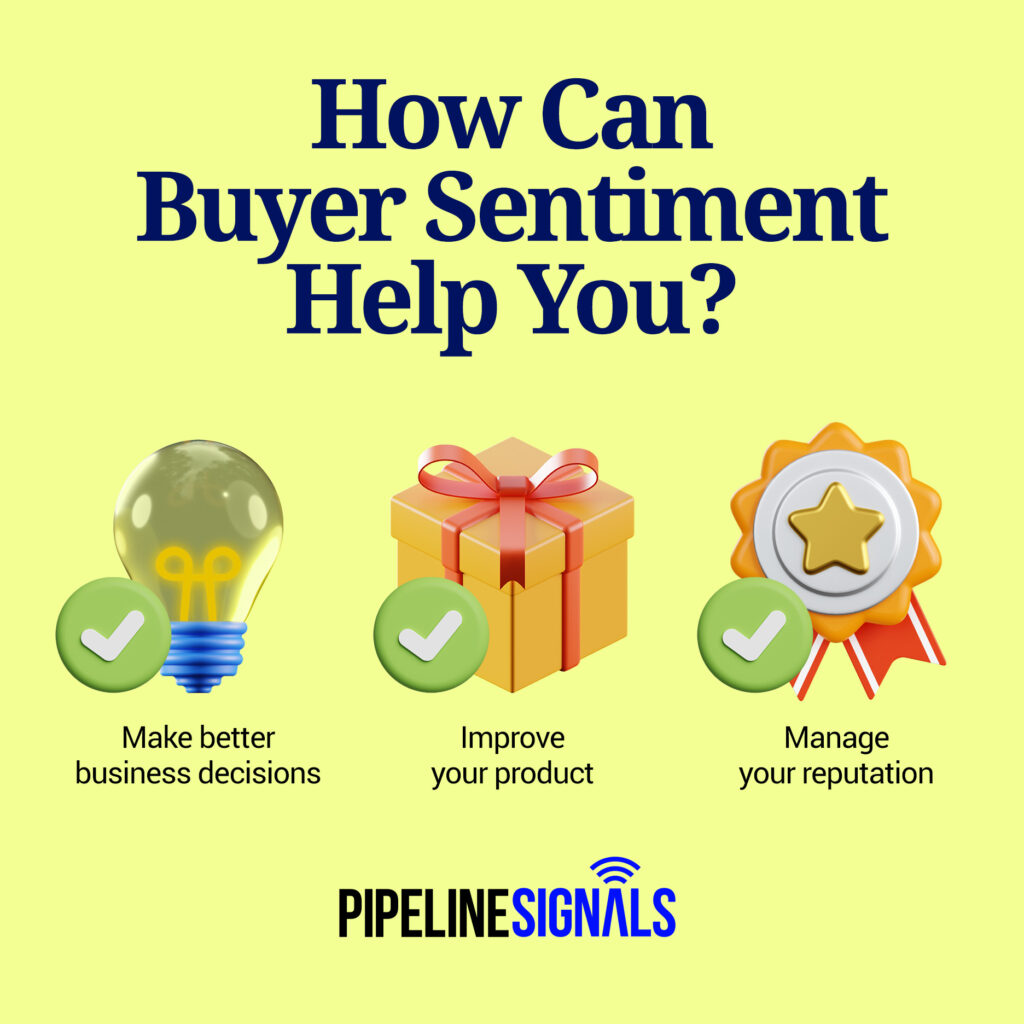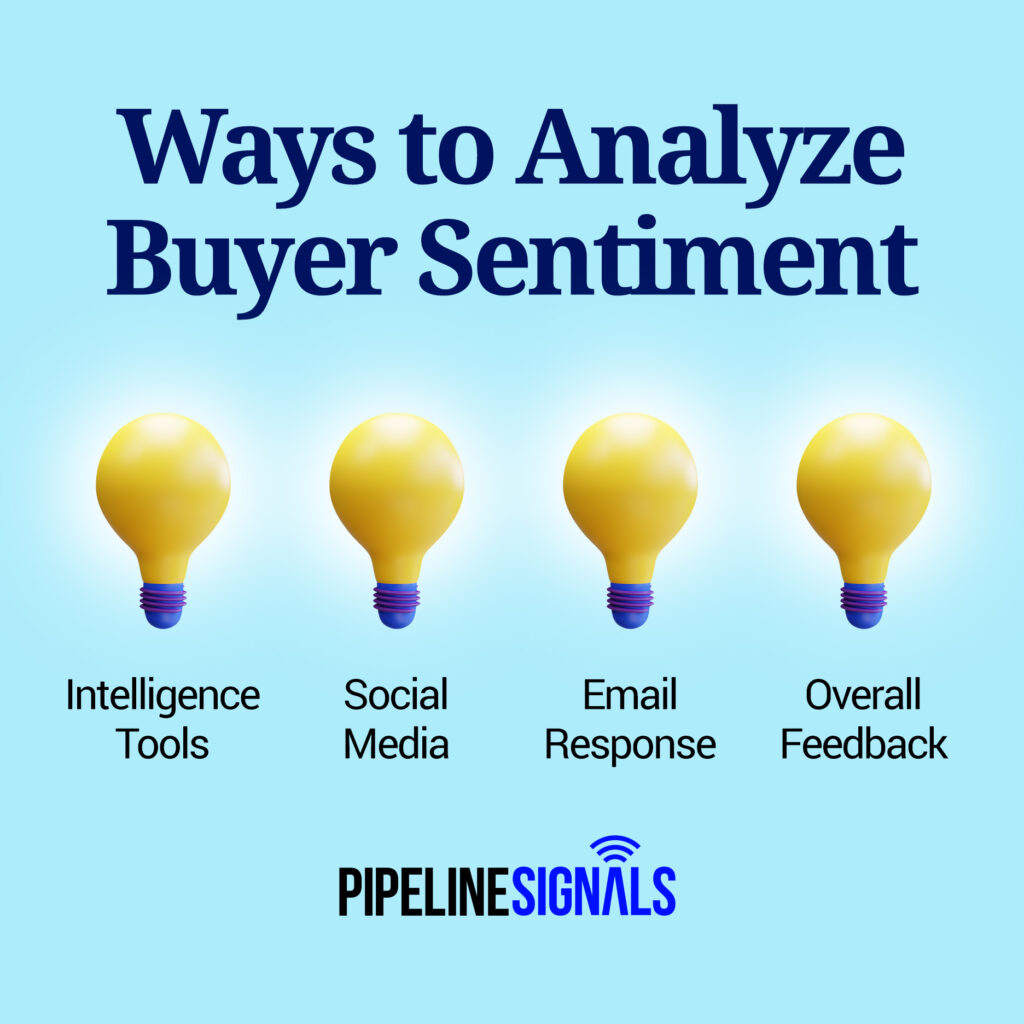The phrases ‘buying behavior’ and ‘buying signals’ relate to customers’ buyer sentiment activities when making a purchase. These actions are frequently used to propel any B2B buying process ahead, in particular, to infer how your sales team should sell. Specific activities, like clicks, opens, and response rates, reveal the how, what, and when of customers’ desire to buy.
However, merely knowing when potential customers respond is ineffective. As your sales staff excitedly anticipate the future, best practice suggests taking a step back and realigning on buying behavior, particularly buyer sentiment—the missing element in many B2B data providers’ engagement strategy.
How do you determine true buyer sentiment?
Buyer sentiment refers to a customer’s emotional response to a sales interaction: good, negative, objection, recommendation, unfollow, unsubscribe. The possibility of the sales process continuing ahead, or even the next best move for your sellers, may be determined by buyer sentiment.
Whether by email or phone, a favorable response to an outreach suggests that the prospective client is eager to learn more about the product or service.
If the prospect responds adversely to outreach, your sellers will need to decide whether another means of contact is the best option. These indicators might also aid sales reps in determining whether or not to collaborate with marketing to develop a nurturing path or if they should wait until later. Buyer sentiment can assist your sales staff in paying attention to what the prospect is saying.
Your sales schedule should also be influenced by buyer sentiment. According to a recent study, the window of opportunity shrinks with each passing day without communicating with the prospective account. As a result, a basic sales rule is to follow up with purchasers as quickly as possible.
While a favorable reaction necessitates quick outreach, continued outreach following a poor response might create more harm than good in the long run, so it’s better to give yourself some time to calm off. In developing sales strategy and pipeline creation, time is essential, so tuning in to emotional cues and reacting quickly and correctly is crucial.
It’s no longer enough just to know whether or not purchasers respond to messages; it’s also essential to understand how effectively they respond. To fully understand a prospect, sales teams must focus on buyer sentiment rather than typical indications of purchasing behavior.
You may learn more about what clients want and anticipate based on these factors. The way you position your company and advertise your product is directly affected by buyer sentiment. You can analyze your customers’ comments and use them to make decisions by digging into your review data. In a nutshell, that is buyer sentiment analysis.
Why is buyer sentiment analysis so important?
You’re probably already keeping track of several metrics. Even yet, for the following reasons, a more profound buyer sentiment research should still be on your consumer analysis shortlist.


Making better business decisions
This is the most important one. B2B companies tell clients what products and services they need right now, so they don’t have to speculate. Your client base, after all, understands your solutions better than anybody else. Buyer sentiment analysis responses reveal precisely what your consumers desire, rather than relying on gut reactions and assumptions.
Improving your products and services regularly
Your business should change in lockstep with your consumers’ habits and expectations. Collecting feedback, monitoring compelling event signals, and performing buyer sentiment analysis may assist you in identifying new products, ideas, and features that people want to see. Encouragement of ratings and reviews establishes a direct line of communication between your customers and your business.
Listening to your clients and enhancing your products have a beneficial influence on your bottom line. The more data you can glean from consumer feedback, the simpler it will be to improve your product.
Managing your reputation with ease
You’ve definitely heard the statistic that almost 90% of consumers trust internet recommendations just as much as personal recommendations. These suggestions may be found all over the internet. While many companies seek out the most cutting-edge influencer marketing strategies, you most likely already have your group of micro-influencers talking about you. The key is to locate this community and equip them with a more effective means of having their opinions heard.
Buyer sentiment analysis helps you catch such moments rather than letting them slide through your fingers when you build conversations around your product. As a consequence, you’ll get a more holistic picture of your online reputation, preventing your company from being trapped in a bubble.
How do you analyze buyer sentiment?
Now that you’ve learned the fundamentals of buyer sentiment, the next step is to figure out how to get started with it all.
Because various organizations prioritize different avenues of consumer input, there is no “right” method for buyer sentiment analysis. That’s why we’ve put together a list of ideas for you to select from based on your industry.


Use intelligence tools to your advantage.
Because there’s so much to go through, buyer sentiment analysis is challenging to conduct “by hand.” Emotions, on the other hand, might be impossible to quantify at a glance. To overcome these obstacles and speed up your buyer sentiment research, we propose utilizing technologies that will handle the job of buyer sentiment analysis by gathering vast amounts of data from your company’s reviews and the industry as a whole.
An intelligence tool is a must-have for companies to find great product insights and fully grasp buyer sentiment without all the digging.
Keep track of what buyers are saying.
Prospective accounts are increasingly using social media to voice their opinions on products and solutions. Social media is a fast-moving platform that provides a rich knowledge of buyer sentiment, whether it’s a shout-out or a customer service issue.
You may use social listening to collect brand mentions (including reviews) and analyze your brand’s social health. These platforms may also be used to monitor trigger signals. In an age where a single contact may derail an entire customer satisfaction effort, buyer sentiment is essential to monitor. There are several strategies to keep track of and listen to social cues.
Listening elements in tools, like Sprout Social, analyze good vs. negative sentiment across social networks and personal remarks. At the same time, businesses and merchants may use review material to listen to similar sentiments.
Collect and organize comments from your email list.
Your buyer sentiment analysis will be more precise if you have more reviews. Given that most purchasers would post reviews if asked, your email list is likely the best way to collect additional reviews.
You poll your current accounts via surveys, questionnaires, and post-purchase messages to find out what they want to see from you in the future.
You can also try setting up post-purchase autoresponder messages to solicit more input as a way to curate reviews passively. When you ask simply and directly, you’d be amazed at how attentive your consumers are.
Anybody who takes the time to respond is clearly involved in your company and hence crucial to your buyer sentiment analysis efforts.
Make sure to evaluate feedback.
It’s essential to keep in mind that not all reviews and comments must be treated equally. There’s a substantial difference between a long-term client leaving a positive review and someone trolling or splitting hairs. As a result, don’t be surprised by outliers in your buyer sentiment analysis; instead, consider the context of your study.
Negative feedback should not be avoided. Thoughtful criticism can help you learn how to enhance your items to get more business in the future. Don’t conceal your buyer sentiment; welcome it and grow from it. Open communication is vital for building trust, so pay attention to your consumers.
Conclusion
Buyer sentiment is just like what we hear from friends and family. When someone gives you advice, you either accept it and try to be better, or you can disagree and choose not to follow it.
The same may be said of buyer sentiment. When you track it, you’ll probably find some things that consumers enjoy and other things that they don’t like about your business. When most people are dissatisfied with something, it’s time to think about if you should adjust what you’re doing. On the other direction, if a considerable proportion of your consumers are satisfied, it’s a strong indication that they don’t want you to change anything.
Regardless of how many clients you have, you should carefully choose which feedback you will use and which you will discard. You can’t please everyone. However, you want your buyer sentiment to be good in general. Keeping track of it, together with compelling event signals and the use of effective B2B marketing strategies, will help you get closer to your pipeline goals.


